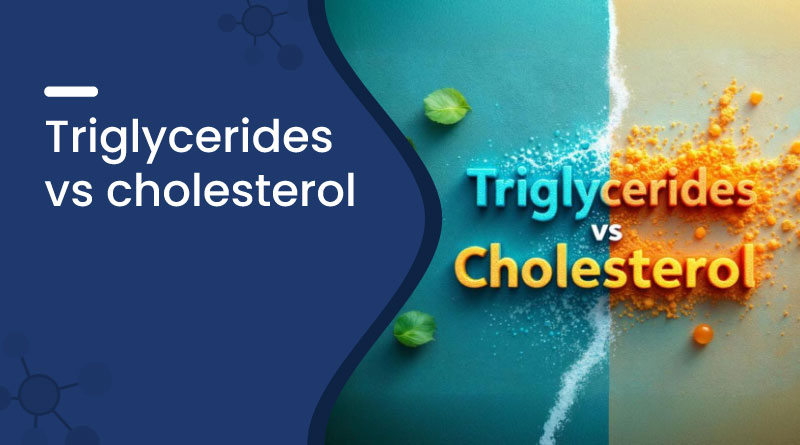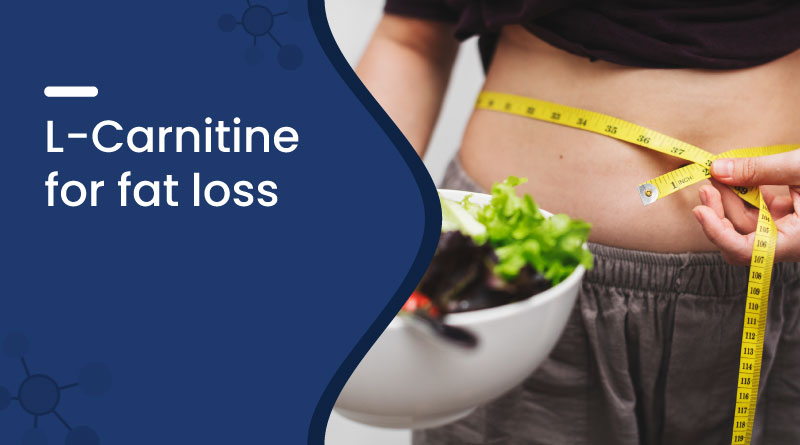Triglycerides vs Cholesterol | Differences & Heart Health


When you get a blood test, you might hear about triglycerides and cholesterol. Both are types of fat in your blood, but they do different jobs. Triglycerides store extra calories for energy, while cholesterol helps build cells, make hormones, and support digestion.
Having too much of either can raise your risk of heart disease, though they affect your body in different ways.
Knowing how each works can help you focus on the right steps to protect your heart health.
Triglycerides and Cholesterol: Importance & Function
Triglycerides
Triglycerides are the main kind of fat found in your body. When you eat more calories than you need, your body turns them into fat and stores them. Later, your body uses this stored fat for energy between meals. High triglycerides (hypertriglyceridemia) are linked to an increased risk of atherosclerosis, pancreatitis, and heart disease.
Cholesterol
Cholesterol is a waxy, fat-like substance that your body needs to build cell membranes, produce vitamin D, and make hormones like estrogen and testosterone. It is carried through your bloodstream in two main forms: LDL (low-density lipoprotein), known as “bad” cholesterol, and HDL (high-density lipoprotein), known as “good” cholesterol. Too much bad cholesterol or too little good cholesterol can clog your arteries.
Benefits of Healthy Triglyceride Levels
- Energy storage and supply: Triglycerides store excess calories for later use, providing essential energy reserves when food is unavailable. This stored fat fuels your body during fasting, prolonged exercise, or illness, supporting muscle activity, brain function, and vital organs until dietary energy becomes available again.
- Supports metabolism: Maintaining healthy triglyceride levels helps regulate energy conversion and fat utilization. Balanced levels prevent excessive fat buildup that can strain organs and promote weight gain while ensuring efficient use of stored energy to sustain bodily functions without disrupting hormone balance or metabolic processes.
- Aids nutrient absorption: Triglycerides enable absorption of fat-soluble vitamins A, D, E, and K in the small intestine. These vitamins support vision, immunity, bone strength, and blood clotting, making adequate triglyceride levels vital for nutrient transport, storage, and optimal use throughout the body.
Benefits of Healthy Cholesterol Levels
- Hormone production: Healthy cholesterol levels supply the body with the raw material to produce sex hormones, adrenal hormones, and vitamin D. These substances regulate reproduction, stress responses, metabolism, and bone strength, making cholesterol essential for overall health, hormonal balance, and daily bodily function.
- Bile production for digestion: The liver uses cholesterol to create bile acids, essential for breaking down dietary fats into absorbable molecules. This process supports nutrient uptake, particularly fat-soluble vitamins like A, D, E, and K, while aiding smooth digestion and preventing digestive discomfort from fatty meals.
- Improve heart function: High-density lipoprotein (HDL) cholesterol transports excess cholesterol from arteries back to the liver for recycling or elimination. This reverse transport reduces plaque buildup, lowers cardiovascular disease risk, supports healthy circulation, and protects against artery hardening, keeping the heart and vascular system healthier.
Nutritional Sources for Healthy Lipid Levels
| For Managing Triglycerides | For Managing Cholesterol |
|---|---|
| Omega-3 supplements (Fish oil, krill oil) — Reduce elevated triglyceride levels. | Sterol and stanol-enriched foods (Fortified margarines, yogurt drinks) — Reduce LDL cholesterol. |
| High-fiber foods (Oats, legumes, flaxseed) — Reduce absorption of fat. | Soluble fiber sources (Psyllium husk, beans, apples) — Bind cholesterol in the digestive tract. |
| Plant-based oils (Olive oil, avocado oil) — Provide healthy unsaturated fats. | Nuts & seeds (Walnuts, chia seeds) — Control cholesterol levels. |
Triglycerides and Cholesterol: What's the Key Difference?
| Aspect | Triglycerides | Cholesterol |
|---|---|---|
| Type | Fat (lipid) used for energy storage. | Waxy, fat-like substance used in body functions. |
| Function | Stores excess calories; releases energy between meals. | Builds cells, makes hormones, aids digestion. |
| High Levels Cause | Increased risk of heart disease, fatty liver, pancreatitis. | Plaque buildup, narrowing of arteries, heart attack risk. |
| Main Influences | Diet high in sugar, refined carbs, excess alcohol, sedentary lifestyle. | Saturated/trans fats, genetics, inactivity, smoking. |
| Target Levels | Below 150 mg/dL. | Total cholesterol: < 200 mg/dL LDL: < 100 mg/dL HDL: ≥ 40 mg/dL (men) / ≥ 50 mg/dL (women) |
Why Is It Important to Keep Both in Check?
Uncontrolled triglycerides and cholesterol contribute to atherosclerosis — a condition where fatty deposits narrow arteries, leading to heart attack, stroke, and peripheral artery disease. Even if one number is within range, the other being high can still harm your heart. Managing both is key to optimal cardiovascular health.
Choosing the Best Health Strategy for You
- For High Triglycerides: Focus on reducing sugar, refined carbs, and alcohol. Increase physical activity, eat more omega-3 rich foods, and aim for weight loss if overweight.
- For High Cholesterol: Prioritize a diet low in saturated/trans fats, rich in fiber, and consider cholesterol-lowering foods or medications if needed.
- For Both: Adopt the Mediterranean diet, which emphasizes fruits, vegetables, whole grains, lean proteins, healthy fats, and moderate physical activity.
Precautions for Managing Triglycerides
- Avoid crash diets (they can temporarily raise triglycerides).
- Limit alcohol, as even small amounts can spike levels in some people.
- Manage blood sugar if diabetic.
- Don’t skip regular lipid panel checks.
Precautions for Managing Cholesterol
- Avoid excessive saturated and trans fats.
- Stop smoking — it lowers HDL and damages arteries.
- Monitor for medication side effects if on statins or other lipid-lowering drugs.
- Keep track of family history — genetics play a big role.
Final Thoughts
Triglycerides and cholesterol may both be lipids, but they play different roles in your body. Triglycerides store energy, while cholesterol supports cell function and hormone production. High levels of either or both can harm your heart. By understanding their differences and taking targeted steps, you can keep your lipid profile in check, reduce disease risk, and support long-term health.
Frequently Asked Questions (FAQs)
Q: Are triglycerides and cholesterol the same thing?
A: No. Both are fats in the blood, but triglycerides store energy, while cholesterol builds cells and makes hormones.
Q: Which is worse for heart health — high triglycerides or high cholesterol?
A: Both can increase heart disease risk; the danger depends on how high they are and whether other risk factors are present.
Q: Can I lower both triglycerides and cholesterol at the same time?
A: Yes. Healthy eating, exercise, weight management, and not smoking improve both.
Q: What foods raise triglycerides the most?
A: Sugary drinks, refined carbs, alcohol, and high-calorie processed foods.
Q: How often should I check my triglyceride and cholesterol levels?
A: Adults should get a lipid panel every 4–6 years, or more often if they have risk factors.
Recent Blogs
Disclaimer : Zeelab Pharmacy provides health information for knowledge only. Do not self-medicate. Always consult a qualified doctor before starting, stopping, or changing any medicine or treatment.
















 Added!
Added!